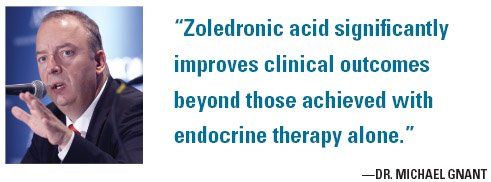Zoledronic acid ups PFS in younger early-stage pts
CHICAGO-Zoledronic acid (Zometa) and adjuvant endrocrine therapy lowered the risk of disease recurrence in premenopausal women with early-stage breast cancer, according to the results of a major European trial. The bisphosphonate is already used to prevent bone loss in women undergoing adjuvant endocrine therapy for breast cancer.
ABSTRACT: Overall good outcomes in the study suggest that many premenopausal women with early-stage breast cancer can avoid chemotherapy.
CHICAGO-Zoledronic acid (Zometa) and adjuvant endrocrine therapy lowered the risk of disease recurrence in premenopausal women with early-stage breast cancer, according to the results of a major European trial. The bisphosphonate is already used to prevent bone loss in women undergoing adjuvant endocrine therapy for breast cancer.
“Zoledronic acid significantly improves clinical outcomes beyond those achieved with endocrine therapy alone,” Michael Gnant, MD, president of the Austrian Breast and Colorectal Cancer Study Group (ABCSG), said at the ASCO 2008 plenary session (abstract LBA-4).
The trial was designed to answer two questions, Dr. Gnant said during an ASCO press conference: “First, can aromatase inhibitors [AIs] improve the outcome of breast cancer patients compared with tamoxifen even in premenopausal patients? Second, can the bisphosphonate zoledronic acid improve the clinical outcome in patients when added to adjuvant endocrine treatment?”
For the ABCSG-12 study, 1,803 premenopausal stage I-II patients undergoing goserelin (Zoladex)-induced ovarian suppression after surgery were enrolled. The majority of the women did not receive chemotherapy, except for about 5% who had preoperative chemotherapy, said Dr. Gnant, professor of surgery, Medical University of Vienna.

The subjects were treated with tamoxifen alone or anastrozole (Arimidex) alone, or with either endocrine therapy with or without zoledronic acid (single dose of 4 mg IV every 6 months) for 3 years. The median follow up is over 5 years.
There was no difference between tamoxifen and anastrozole in disease-free, recurrence-free, or overall survival, “possibly because of the dominant effect of ovarian suppression with goserelin in premenopausal patients,” he said.
Endocrine therapy plus zoledronic acid reduced the risk of disease-free survival events by 36%, compared with endocrine therapy alone (P = .011). Adding the bisphosphonate to the endocrine treatment regimen also reduced the risk of relapse-free survival events by 35% (P = .015), Dr. Gnant reported.
Zoledronic acid reduced events in categories besides bone metastases, such as locoregional occurrence, distant non-bone metastases, and lesions in the contralateral breast. He suggested that zoledronic acid may be causing a hostile environment for the tumor and killing micrometastases elsewhere in the body.
Dr. Gnant acknowledged that the study did not have enough statistical power to offer a definite conclusion on overall survival, “due to the fortunate low number of deaths in the trial as yet,” he said, although there was a trend toward favorable results in the zoledronic acid arms.
An important finding, was the excellent outcomes these patients achieved without chemotherapy. At 5-year follow-up, in the overall trial cohort, disease-free survival was 94% and overall survival 98.2%. “This adds to the growing evidence that low-and intermediate-risk premenopausal patient subgroups with endocrine responsive early breast cancer can be spared the side effects of cytotoxic therapy after locoregional treatment,” he said.
No osteonecrosis of the jaw
Dr. Gnant said that treatment was well tolerated, with no major adverse events. “With IV bisphophonates, one is concerned with osteonecrosis of the jaw (ONJ),” he said. “We have been carefully following our patients, and we had three suspected cases. We have been able to go back to the dental films, and there was not a single confirmed case of ONJ.”
He also cautioned that these results could not be applied to other bisphosphonates that are currently on the market. He told ONI that if he had a patient who was already being treated with bisphosphonates at the time of cancer diagnosis, he would switch her to zoledronic acid.
Commentary
For Eric Winer, MD, of the Dana-Farber Cancer Institute, an important take home message from the trial is the strong evidence that a subgroup of premenopausal women may be able to skip chemotherapy. “There were very few recurrences using endocrine therapy alone,” he said at the ASCO press conference.
He also advised against extrapolating the findings from the bisphosphonate question to a wider patient population. “A 3-year course of bisphophonates is not the new standard of care for all women with breast cancer,” he said. “The study showed a reduction in recurrence risk with zoledronic acid in these premenopausal women with hormone-receptor-positive disease receiving ovarian suppression. While it has yet to show an improvement in overall survival, the reduction in recurrence is sufficient to recommend zoledronic acid for women receiving treatment as administered in the trial.”
Discussant Martine Piccart-Gebhart, MD, PhD, chair of the Breast International Group, praised the study for building on previous research indicating that goserelin plus tamoxifen is superior to chemotherapy. She also pointed out that the study was not double-blinded, patients were not stratified for HER2 status, and the regimen used as a control (gosereline plus tamoxifen) is not widely accepted.
She posed several questions that need to be answered before the addition of zoledronic acid to endocrine therapy can be widely recommended:
• Is the magnitude of benefit larger for an AI than for tamoxifen?
• Could a more intensive zoledronic acid schedule be more effective, and would it be safe?
• How long should zoledronic acid therapy continue?
• What are the implications for other tumor types?
ABCSG-12 results should not change practice, she said, but do mark an important paradigm shift, opening avenues for new strategies in early-stage disease.
Finally, she pointed to the AZURE trial in women with high-risk stage II-III breast cancer treated with neoadjuvant or adjuvant chemotherapy and/or hormonal therapy with and without an intensive schedule of zoledronic acid. Results are due later this year.